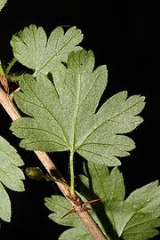
Ribes divaricatum
Encyclopedia
Ribes divaricatum is a species of currant
Ribes
Ribes is a genus of about 150 species of flowering plants native throughout the temperate regions of the Northern Hemisphere. It is usually treated as the only genus in the family Grossulariaceae. Seven subgenera are recognized....
with three accepted varieties, and known by several common names, found in the forests, woodlands, and coastal scrub of western North America from British Columbia
British Columbia
British Columbia is the westernmost of Canada's provinces and is known for its natural beauty, as reflected in its Latin motto, Splendor sine occasu . Its name was chosen by Queen Victoria in 1858...
to California
California
California is a state located on the West Coast of the United States. It is by far the most populous U.S. state, and the third-largest by land area...
.
Varieties
- The type variety (and autonymAutonym (botany)In botanical nomenclature, autonyms are automatically created names, as regulated by the International Code of Botanical Nomenclature . Autonyms are cited without an author. Relevant provisions are in articles 6.8, 22.1-3 and 26.1-3....
), R. d. var. divaricatum, or spreading gooseberry is found in OregonOregonOregon is a state in the Pacific Northwest region of the United States. It is located on the Pacific coast, with Washington to the north, California to the south, Nevada on the southeast and Idaho to the east. The Columbia and Snake rivers delineate much of Oregon's northern and eastern...
, Washington, and British Columbia.
- R. d. var. parishii, called Parish's gooseberry, is found only in California.
- R. d. var. pubiflorum, known as straggly gooseberry is native to both California and Oregon.
Other common names include coast black gooseberry, and wild gooseberry.
Description
R. divaricatum is a shrubShrub
A shrub or bush is distinguished from a tree by its multiple stems and shorter height, usually under 5–6 m tall. A large number of plants may become either shrubs or trees, depending on the growing conditions they experience...
sometimes reaching 3 meters in height with woody branches with one to three thick brown thorns at leaf nodes. The leaves are generally palmate in shape and edged with teeth. The blades are up to 6 centimeters long and borne on petioles
Petiole (botany)
In botany, the petiole is the stalk attaching the leaf blade to the stem. The petiole usually has the same internal structure as the stem. Outgrowths appearing on each side of the petiole are called stipules. Leaves lacking a petiole are called sessile, or clasping when they partly surround the...
.
The inflorescence
Inflorescence
An inflorescence is a group or cluster of flowers arranged on a stem that is composed of a main branch or a complicated arrangement of branches. Strictly, it is the part of the shoot of seed plants where flowers are formed and which is accordingly modified...
is a small cluster of hanging flowers, each with reflexed purple-tinted green sepal
Sepal
A sepal is a part of the flower of angiosperms . Collectively the sepals form the calyx, which is the outermost whorl of parts that form a flower. Usually green, sepals have the typical function of protecting the petals when the flower is in bud...
s and smaller, lighter petals encircling long, protruding stamen
Stamen
The stamen is the pollen producing reproductive organ of a flower...
s. The fruit is a berry
Berry
The botanical definition of a berry is a fleshy fruit produced from a single ovary. Grapes are an example. The berry is the most common type of fleshy fruit in which the entire ovary wall ripens into an edible pericarp. They may have one or more carpels with a thin covering and fleshy interiors....
up to a centimeter wide which is black when ripe. It is similar to Ribes lacustre
Ribes lacustre
The shrub Ribes lacustre is known by the common names prickly currant, swamp gooseberry, and black gooseberry. It is widely distributed, from California to Alaska and across North America to Pennsylvania and Newfoundland....
and Ribes lobbii
Ribes lobbii
Ribes lobbii is a shrubby, deciduous, shade-intolerant perennial dicot found on the western coast of North America. It was first described in 1876 by Asa Gray...
, but the former has smaller, reddish to maroon flowers and the latter has reddish flowers that resemble those of fuchsia
Fuchsia
Fuchsia is a genus of flowering plants that consists mostly of shrubs or small trees. The first, Fuchsia triphylla, was discovered on the Caribbean island of Hispaniola in 1703 by the French Minim monk and botanist, Charles Plumier...
s and sticky leaves.
Traditional Native American medical plants
The fruit was food for a number of Native AmericanIndigenous peoples of the Americas
The indigenous peoples of the Americas are the pre-Columbian inhabitants of North and South America, their descendants and other ethnic groups who are identified with those peoples. Indigenous peoples are known in Canada as Aboriginal peoples, and in the United States as Native Americans...
groups of the Pacific Northwest
Pacific Northwest
The Pacific Northwest is a region in northwestern North America, bounded by the Pacific Ocean to the west and, loosely, by the Rocky Mountains on the east. Definitions of the region vary and there is no commonly agreed upon boundary, even among Pacific Northwesterners. A common concept of the...
, and other parts of the plant, especially the bark
Bark
Bark is the outermost layers of stems and roots of woody plants. Plants with bark include trees, woody vines and shrubs. Bark refers to all the tissues outside of the vascular cambium and is a nontechnical term. It overlays the wood and consists of the inner bark and the outer bark. The inner...
, was used for medicinal purposes.

